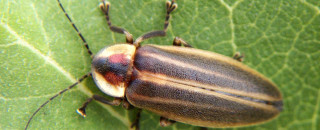Firefly Sightings in Utah
June 17, 2015 —Natural History Museum of Utah entomologist Christy Bills wasn’t sure what to think, when people first began reporting firefly sightings around the state. Not until someone brought her a firefly they had caught did she begin to think more about it. Of course, anyone who has spent time east of Colorado knows lightning bugs can be plentiful on a muggy summer night. Firefly sightings are much more common in warm, humid regions around the globe. Yet it seems more and more rural Utah residents are coming forward with lightning bug stories of their own. People from Cache County to Lake Powell have reported seeing zigzagging amber lights in meadows, marshes, and damp mosquito-infested regions—each a perfect riparian breeding ground, where female fireflies can deposit their eggs.
Fireflies are in fact, beetles, members of the Lampyridae family. They have chewing mouthparts, straight-line wings, and their larva thrive in damp, marshy areas, where they feed on snails and worms they inject with toxins. After several years underground firefly larva metamorphosis into adults. Some eat only nectars, some eat nothing at all, and still others become predatory for the few short weeks they live as adults.
Of the 150 species found in North America, all larva glow, but not all adult fireflies glow. Researchers in Utah say that of the species found in Utah, only a few of them blink. Blinking patterns of different species also varies, with males attracting females by blinking as they fly. In response, females blink back, but some females blink to attract other species they hope to eat.
Researchers say firefly populations are quickly dwindling across the country due to habitat loss, possibly from commercialization of wetlands, pesticides, and increased light pollution (inhibiting firefly reproduction signals).
Partnering with scientists at BYU, Christy and her colleagues are asking for citizen participation to help map additional sightings and firefly locations. Their hope is to track known and potentially new species, and to gather additional information about Utah firefly sightings and habitats. Visit the Citizen Science Project to see where fireflies have already been spotted and to record your own findings, should you be lucky enough to happen upon these rare and mysterious creatures. Many eyewitnesses say 9:30-10:00 p.m. is the primetime pyrotechnic hour. Utah sightings have been reported as early as May up through the fourth of July—don’t forget a jar or net if you’re hoping to catch one.
Happy hunting!
Press contacts and links
-
Press Contact
Beth Mitchell
